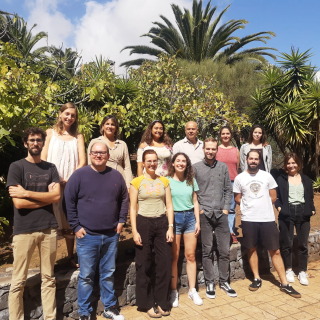Bibcode
Ryś, A.; Grocholski, A. J.; van der Marel, R. P.; Aloisi, A.; Annibali, F.
Bibliographical reference
Astronomy and Astrophysics, Volume 530, id.A23
Advertised on:
6
2011
Journal
Citations
13
Refereed citations
13
Description
Context. Central starbursts in galaxies are an extreme example of
ongoing galaxy evolution. The outer parts of galaxies contain a fossil
record of galaxy formation and evolution processes in the more distant
past. The characterization of resolved stellar populations allows one a
detailed study of these topics. Aims: We observed the outer parts
of NGC 1569 and NGC 4449, two of the closest and strongest dwarf
starburst galaxies in the local universe, to characterize their stellar
density and populations, and obtain new insights into the structure,
formation, and evolution of starburst galaxies and galaxy halos.
Methods: We obtained HST/WFPC2 images between 5 and 8 scale radii from
the center, along the intermediate and minor axes. We performed
point-source photometry to determine color magnitude diagrams of I vs. V
- I. We compared the results at different radii, including also our
prior HST/ACS results for more centrally located fields. Results:
We detect stars in the RGB and TP-AGB (carbon star) phases in all outer
fields, but not younger stars such as those present at smaller radii.
The RGB star density profile is well fit by either a de Vaucouleurs
profile or a power-law profile, but has more stars at large radii than a
single exponential. To within the uncertainties, there are no radial
gradients in the RGB color or carbon-to-RGB-star ratio at large radii.
Conclusions: The galaxies have faint outer stellar envelopes that
are not tidally truncated within the range of radii addressed by our
study. The density profiles suggest that these are not outward
extensions of the inner disks, but are instead distinct stellar halos.
This agrees with other work on galaxies of similar morphology. The
presence of such halos is consistent with predictions of hierarchical
galaxy formation scenarios. The halos consist of intermediate-age/old
stars, confirming the results of other studies that have shown the
starburst phenomenon to be very centrally concentrated. There is no
evidence for stellar-population age/metallicity gradients within the
halos themselves.
Related projects

Traces of Galaxy Formation: Stellar populations, Dynamics and Morphology
We are a large, diverse, and very active research group aiming to provide a comprehensive picture for the formation of galaxies in the Universe. Rooted in detailed stellar population analysis, we are constantly exploring and developing new tools and ideas to understand how galaxies came to be what we now observe.
Anna
Ferré Mateu